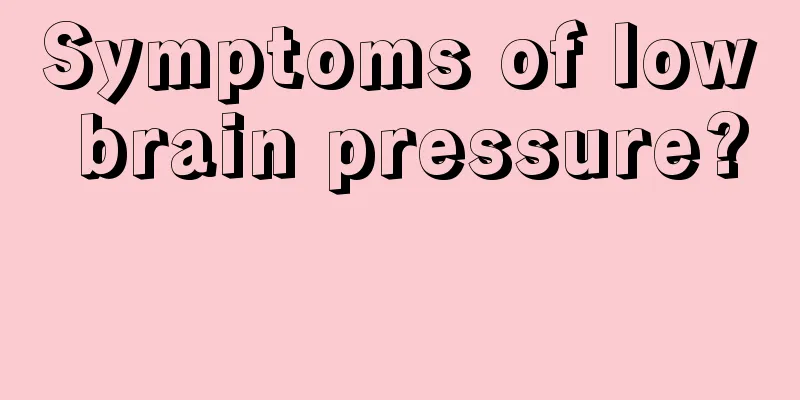Symptoms of low brain pressure?

|
Generally speaking, there are two main causes of low intracranial pressure, primary and symptomatic. The causes of most primary intracranial low pressure are unclear, and symptomatic intracranial low pressure is mostly related to craniocerebral injury. If dizziness and headaches occur frequently, it is best to go to the hospital for examination and treatment as soon as possible. Do not take medication indiscriminately and be sure to actively treat it under the guidance of a doctor. What are the symptoms of high brain pressure? 1. Headache is the most common symptom of intracranial hypertension. The higher the intracranial pressure, the more obvious the headache is, and it is mostly diffuse dull pain. The pain usually occurs in the morning and often worsens in a continuous or paroxysmal manner. Any factors that cause increased intracranial pressure, such as coughing, defecation, etc., can aggravate the pain. Headaches may be relieved by vomiting or hyperventilating. Acute increased intracranial pressure causes severe headache, restlessness, and is often accompanied by projectile vomiting. 2. Vomiting, which is generally unrelated to diet, with or without nausea before vomiting, often projectile, and often accompanied by severe headache and dizziness. When the headache is severe, the vomiting symptoms are also more severe. 3. Visual impairment, manifested as transient amaurosis, gradually developing into decreased vision or even blindness. Fundus examination may reveal papilledema, venous dilation and hemorrhage. Compression may cause diplopia, but acute intracranial hypertension may not cause papilledema. 4. Impaired consciousness, irritability, indifference, dullness, drowsiness, and even coma. 5. Epilepsy or limb tonic seizures What are the causes of high brain pressure? (1) Increased brain volume: Brain edema caused by various intracranial causes, such as encephalitis and meningitis. (2) Increase in intracranial blood volume: Carbon dioxide accumulation due to various reasons, such as respiratory failure, causes cerebral vasodilation and a rapid increase in cerebral blood flow. (3) Increased cerebrospinal fluid volume: excessive cerebrospinal fluid secretion or absorption disorder; obstruction of cerebrospinal fluid circulation caused by various reasons. (4) Intracranial space-occupying lesions: A certain space in the cranial cavity is occupied by focal lesions, such as intracranial hemorrhage or hematoma caused by spontaneous or craniocerebral injury; primary and metastatic intracranial tumors, intracranial abscesses, granulomas, various parasites, etc. (5) Physiological regulation dysfunction: In systemic diseases such as sepsis, ischemia, and hypoxia, the physiological regulation mechanism of intracranial pressure is impaired, which can increase intracranial pressure. There are many pain-sensitive structures in the skull, such as the dura mater, large blood vessels, and cranial nerves. When intracranial pressure increases, the blood vessels and meninges in the skull are displaced and pulled, causing high intracranial pressure pain. What to do if you have high brain pressure 1. Maintain the patient's breathing: We will give oxygen, suction or ventilator according to the situation, and raise the head of the bed 25 to 30 degrees to reduce brain pressure. A nasogastric tube may be inserted initially to relieve gastrointestinal pressure and prevent vomiting and aspiration pneumonia. 2. Medical staff will closely monitor the patient's vital signs and neurological condition. 3. Limit water intake: Generally, the patient will be fasted for 8 to 24 hours to facilitate observation. After that, the patient may be restricted in water intake (including food and intravenous drips) to reduce cerebral edema. 4. Diet: If the patient's consciousness or swallowing ability is poor, he will be fed through a gastric tube. When the condition improves, the amount of food can be gradually increased. 5. Drug treatment: The doctor will give drugs such as anticonvulsants, anti-cerebral hypertension drugs, antibiotics, and tetanus vaccines according to the patient's symptoms and needs. 6. Surgery: There are different surgical methods for injuries to different parts of the body. The doctor will explain them to you individually before the operation. |
<<: The first symptoms of thermal insulation?
>>: What are the symptoms of high blood sugar in babies?
Recommend
How to clean an air humidifier
After using the air humidifier for a period of ti...
How to get rid of the onion smell in your mouth
We know that green onions have many benefits to t...
How many years can you live after mid-term liver cancer resection
Since the survival time of some patients with adv...
Do you know the symptoms of skin test allergy?
In our daily lives, doctors usually do skin tests...
Snake skin removal is effective
Snake skin usually refers to ichthyosis. The effe...
Causes of bone metastasis of lung cancer
Lung cancer care is also very important for patie...
My eyes hurt and I can't open them, what's going on?
There are various reasons why your eyes cannot be...
What are the effects and functions of fried broad beans?
Broad beans are also called Hu beans, Buddha bean...
What medicine to take for pyloric edema
In fact, it is impossible to detect pyloric edema...
There is a bump on the index finger joint
Pimples are not unfamiliar to people. They can be...
There are red spots on the root of the tongue
The color of the tongue coating is a way to check...
What nutrients are absorbed slowly by the stomach?
Health is very important to us. To maintain healt...
What are the obvious manifestations of early symptoms of colon cancer
In recent years, the number of patients with colo...
Sub-health is not scary, the key is to insist on "prevention"
How to alleviate sub-health is an urgent matter. ...
What are the items in the endometrial cancer review? Review these categories
The follow-up items for endometrial cancer vary a...









